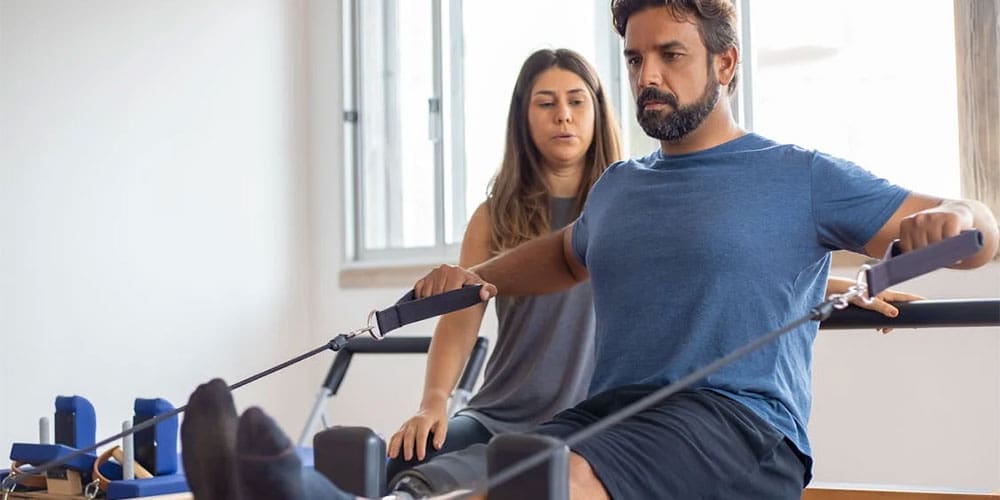
Auto accidents are one of the most common ways people experience injuries. For many, minor accidents cause only mild injuries, if any at all. Unfortunately, though, accidents can cause serious injuries that upend your life and require a lengthy healing process.
Targeted exercises and stretches are often an important part of the recovery process. Working with a healthcare professional ensures that the exercises you include in your recovery routine are safe and effective for treating your injuries.
Car accidents can cause a wide variety of injuries. The following are the most common motor vehicle accident injuries and the most effective exercises for helping you recover:
The best exercises for whiplash focus on improving mobility, strength, and stability without straining injured tissues. Start with gentle, controlled movements and gradually progress as tolerated.
Some of the best exercises for whiplash include:
Perform gentle stretches to increase flexibility and range of motion in the neck muscles. Examples include neck tilts, side bends, and rotations.
Strengthening exercises help stabilize the neck and support proper posture. Examples include neck isometrics (resisting against your hand in different directions), neck flexion and extension exercises using resistance bands, and chin tucks.
Strengthening the neck muscles can help reduce strain and improve overall posture. Exercises such as shoulder blade squeezes, rows, and shoulder shrugs can be beneficial.
If your accident has left you with back pain, exercises targeting your core muscles and the lumbar and thoracic regions can help alleviate discomfort, improve flexibility, and promote overall spine health.
Some of the best rehabilitation exercises for back pain include:
Sprains and strains are incredibly common injuries for accident victims. Some of the best exercises for recovering from sprains and strains include:
Perform static contractions of the muscles surrounding the injured area without moving the joint.
Use resistance bands to perform low-impact strengthening exercises for the affected muscles and joints.
Shoulder injuries resulting from car accidents can vary in severity, from mild strains to more serious conditions such as rotator cuff tears or dislocations. Regardless of the specific injury, incorporating rotator cuff strengthening exercises, mobility exercises, and proper posture alignment into your rehabilitation program can help promote healing, reduce pain, and improve function.
Some of the best rotator cuff injury recovery exercises include:
Other common injuries linked to car accidents include injuries to the wrist, elbow, and hip. Regardless of your injuries or combination of injuries, it's best to seek professional guidance when creating a recovery exercise plan.
Several general tips can help you prevent injuries when beginning a new exercise or stretching routine:
It's best to ease into an exercise routine, especially when your body is still healing from an auto accident injury. Over time, you can increase the intensity and duration of the exercises.
This is one of the most essential tips for anyone beginning an exercise program, but it's essential when exercising for recovery. There's no need to push yourself – you aren't in training or competing to win anything. Tune into the signals you're getting from your body and stop if you experience pain.
A lot of rehabilitation exercises look simple, but if done wrong, they can lead to further injury. This is why it's essential to work with an experienced professional. In some cases, they can show you how to do the exercises correctly using proper form and technique, and then you'll be able to do the routine at home on your own.
Like all exercise routines, you'll want to warm up and cool down. This helps you avoid injury and prevents you from feeling worse a few hours after exercising.
Recovering from an auto accident can be difficult. Depending on the injuries, performing your daily routine tasks can take a great deal of effort. It's important to remember to stay active and maintain a healthy lifestyle, even if these things are more challenging after an accident. This ensures optimal recovery and supports your body's natural ability to heal.
It's also important to seek professional guidance from a physical therapist or certified personal trainer. They can design a personalized therapeutic exercise plan that's ideal for your body and specifically addresses your injuries. Over time, these plans can be modified as you recover.
In addition to exercise and stretching, you might like access to additional online resources or support groups to provide information, motivation, and support. For example:
In addition to following a personalized exercise plan, it's also essential to maintain as positive an attitude as you can. The days, weeks, and months after an auto accident can be challenging. If needed, reach out to healthcare professionals for support and/or counseling.

© Accident Care Chiropractic | Hablamos Español
Located in: North Portland, NE Portland, SE Portland, Gresham, Clackamas, Oregon City, Hillsboro, Bethany, Beaverton, Tigard, Forest Grove, Woodburn,
McMinnville, Keizer, Salem, South Salem, Bend, Springfield, Vancouver, Hazel Dell, East Vancouver, Pasco, Kennewick, Lakewood.
We Specialize in Car Accident Treatment & Recovery
Home | About Us | Testimonials | Blog | Sitemap | Privacy Policy | Services | Locations | Contact Us